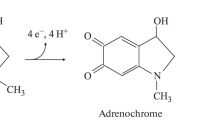Abstract
The physico-chemical characteristics and possible formation mechanisms of negative air ions are considered. It was found that the products of oxygen and nitrogen negative ionization reduce ferricytochromec and nitroblue tetrazolium, and that these reactions were inhibited by superoxide dismutase. The interaction of negatively ionized oxygen with water led to hydrogen peroxide accumulation, which was inhibited by tetranitromethane or catalase. Nitrogen ionization under these conditions caused the formation of the hydrated electron e —aq and the superoxide anion O —2 . The data obtained indicate that the biological activity of negative air ions may be dependent on superoxide. The generation of reactive oxygen ions in the gas phase and also at a gas/water interface is described. A scheme for superoxide production under oxygen and nitrogen ionization is proposed.
Similar content being viewed by others
References
Anclair C, Voisin E (1987) Nitroblue tetrazolium reduction. In: Greenwald RA (ed) CRC handbook of methods for oxygen radical research. CRC Press, Boca Raton, Florida, pp 123–132
Babko AK, Dubovenko LI, Lukovskaya NM (1966) Chemiluminescent analysis. Naukova Dumka Kiev (in Russian)
Byczkowski JZ, Gessner T (1988) Biological role of superoxide ion-radical. Int J Biochem 20:569–580
Dolezalek H (1985) Remarks on the physics of atmospheric ions (natural and artificial). Int J Biometeorol 29:211–221
Fridovich I (1983) Superoxide radical: an endogenous toxicant. Annu Rev Pharmacol Toxicol 23:239–257
Fridovich I (1987a) CytochromeC. In: Greenwald RA (ed) CRC handbook of methods for oxygen radical research. CRC Press, Boca Raton, Florida, pp 121–122
Fridovich I (1987b) CytochromeC. In: Greenwald RA (ed) CRC handbook of methods for oxygen radical research. CRC Press, Boca Raton, Florida, pp 213–215
Fridovich I (1989) Superoxide dismutases. An adaptation to a paramagnetic gas. J Biol Chem 264:7761–7764
Goldstein NI (1982) The stability of some biosubstrates and its models to peroxidation in atmosphere of air ions. In: Bluger A (ed) Liver cellular and subcellular pathology. Zinātne, Riga, pp 91–96 (in Russian)
Goldstein NI (1986) Chemiluminescent indicator. In: Juravlew A (ed) Bioluminescence in agriculture. All-Union State Agricultural Academy Moscow, pp 27–28 (in Russian)
Goldstein NI (1988) Air ions: The possible role of activated oxygen species in mechanisms of biological action. In: Goldstein NI (ed) Oxygen radicals in chemistry, biology and medicine. Riga Medical Institute, pp 80–108 (in Russian)
Kellog EW, Yost MG, Barthakur N, Krueger AP (1979) Superoxide involvement in the bactericidial effect of negative air ions onStaphylococcus albus. Nature 281:400–401
Kröling P (1985) Natural and artifically produced air ions — a biologically relevant climate factor? Int J Biometeorol 29:233–242
Krueger AP, Reed EJ (1976) Biological impact of small air ions. Science 193:1209–1213
Krueger AP, Reed EJ, Brook KB, Day MB (1975) Air ion action on bacteria. Int J Biometeorol 19:65–71
Pethig R (1984) Survey of the methodology for evaluating negative air ions: Relevance to biological studies. Methods Enzymol 105:238–248
Rosenthal I, Ben-Hur E (1980) Superoxide involvement in negative air ion effects. Nature 288 (5972):739
Seki H, Ilan YA, Ilan Y, Stein G (1976) Reactions of the ferri/ferrocytochrome-C system with superoxide/oxygen and CO −2 /CO2 studied by fast pulse radiolysis. Biochem Biophys Acta 440:573–586
Streffer C (1969) Strahlen-Biochemie. Springer, Berlin Heidelberg New York, p 195
Sulman FG, Levy D, Lunkan L, Pfeufer Y, Tal E (1978) Absence of harmful effects of protracted negative air ionization. Int J Biometeorol 22:53–58
Tchijevsky AL (1960) Aeroionification in national economy. Publishing House of the State Planing Commision of the USSR, Moscow, p 758 (in Russian)
Author information
Authors and Affiliations
Rights and permissions
About this article
Cite this article
Goldstein, N.I., Goldstein, R.N. & Merzlyak, M.N. Negative air ions as a source of superoxide. Int J Biometeorol 36, 118–122 (1992). https://doi.org/10.1007/BF01208923
Received:
Accepted:
Issue Date:
DOI: https://doi.org/10.1007/BF01208923




